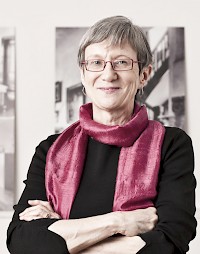Vita
Linda Dalrymple Henderson earned her Ph.D. at Yale University and has taught twentieth-century European and American art in the Department of Art and Art History at the University of Texas, Austin since 1978. Before coming there, she served from 1974 through 1977 as Curator of Modern Art at the Museum of Fine Arts, Houston. A Guggenheim Fellow in 1988-89, Linda Dalrymple Henderson is a member of the Academy of Distinguished Teachers and holds the David Bruton, Jr. Centennial Professorship in Art History. In 2003 Linda Henderson co-organized in Austin the national conference of the Society for Literature and Science (now the Society for Literature, Science, and the Arts) on the theme »Rethinking Space and Time Across Science, Literature, and the Arts.«
Dated from 2010
Fields of research
Twentieth Century European and American Art, with emphasis on the period 1900–1930; interdisciplinary study of modernism, including the relation of modern art to fields such as geometry, science and technology, and mystical and occult philosophies.
IKKM Research Project
The Energies of Modernism: Art and Science in the Early 20th Century
No history exists of the development of modern art in the context of the late 19th and early 20th-century science that served as its backdrop and, very often, its stimulus. Although the key developments in Relativity physics occurred in 1905, 1908, and 1916, Einstein was little known outside the world of science before he was catapulted to fame by the November 1919 eclipse expedition that proved one of his theory's predictions. Instead, the public's understanding of "science" in the early 20th century was grounded in the series of developments from the mid-1890s onward that had transformed contemporary conceptions of matter and space. Röntgen’s discovery of the X-ray (1895), Thomson’s identification of the electron (1897), the Curies’ isolation of radioactive elements (1898), Rutherford’s subsequent work on the structure of the atom, and the emergence of wireless telegraphy all pointed to an invisible reality beyond the reach of sense perception. Moreover, science in this period was not distant from daily life, since its applications, such as medical X-rays and wireless telegraphy, were radically transforming modes of seeing and communicating.
Avant-garde artists in the early 20th century thus shared a common culture of popularized science that has been virtually ignored in histories of modern art or of modernism in general. A central element of that world view was the ether of space, which did not disappear with Einstein's publication of the Special Theory of Relativity in 1905, contrary to standard narratives of this history. Understood to suffuse all space and matter, serving as the necessary medium for visible and invisible vibrating electromagnetic waves, the ether had also come to be viewed as a potential source of matter itself. It was also a powerful signifier of continuity in the early 20th century, documented in Umberto Boccioni's designation of the ether as the "unique form of continuity in space," the title of his best-known sculpture. The vibratory ether was often connected as well to a second element of the early 20th-century fascination with invisible "meta-realities"--the widespread belief in the possible existence of a suprasensible fourth dimension of space. The ether and the fourth dimension met the same fate, once Einstein's ideas gained scientific and popular acceptance. (Einstein redefined the fourth dimension as time and declared the ether to have no mechanical properties.) The paradigm shift that occurred after that moment suggests that early 20th-century art (and literature) should be discussed in the context of two "modernisms."
Another little-noted aspect of pre-1920s modernism, grounded in ether physics, was a widespread openness to the occult. Indeed, both the ether and the fourth dimension were sites where science and occultism readily intersected. It was in this context that figures such as the French doctor Hippolyte Baraduc could thrive as he sought to photograph patterns of vibrating ether bearing exteriorizations of thought. Recovering the popular scientific milieu of this period, along with closely related occult ideas, illuminates the art and theory of a variety of early 20th-century artists who shared the culture of what might be termed "vibratory modernism." That is especially true for figures such as Boccioni, František Kupka, and Wassily Kandinsky, for whom both science and occultism were vital touchstones.
Publications
»Modernism and Science«, in: Vivian Liska and Astradur Eysteinsson (ed.): Modernism, Amsterdam: John Benjamins 2007, p. 383-403.
»Space, Time and Space-Time. Changing Identities in the Fourth Dimension in Twentieth-Century Art«, in: Lucinda Barnes (ed.): Measure of Time, Berkeley: Berkeley Museum of Art and Pacific Film Archive 2007, p. 86-101.
Four-Dimensional Space or Space-Time: The Emergence of the Cubism-Relativity Myth in New York in the 1940s, in: Michèle Emmer (ed.): The Visual Mind II, Cambridge: MIT Press 2005, p. 349-397.
(ed): Writing Modern Art and Science, Cambridge: Cambridge University Press 2004.
with Bruce Clarke (ed.): From Energy to Information: Representation in Science and Technology, Art, and Literature, Stanford: Stanford University Press 2002.
Duchamp in Context: Science and Technology in the Large Glass and Related Works, Princeton: Princeton University Press 1998.
The Fourth Dimension and Non-Euclidean Geometry in Modern Art, Princeton: Princeton University Press, 1983.
